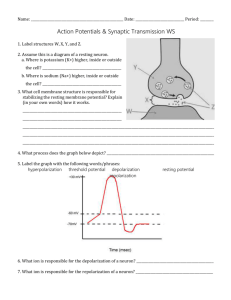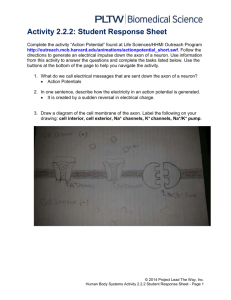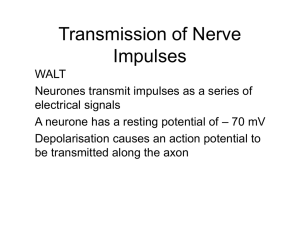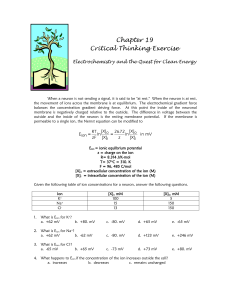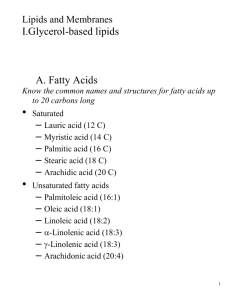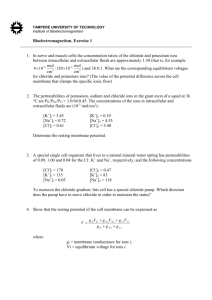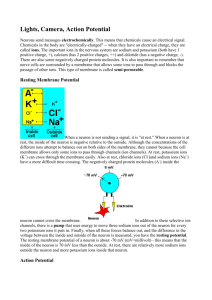PART 1. Begin this tutorial by going to the following website:
advertisement
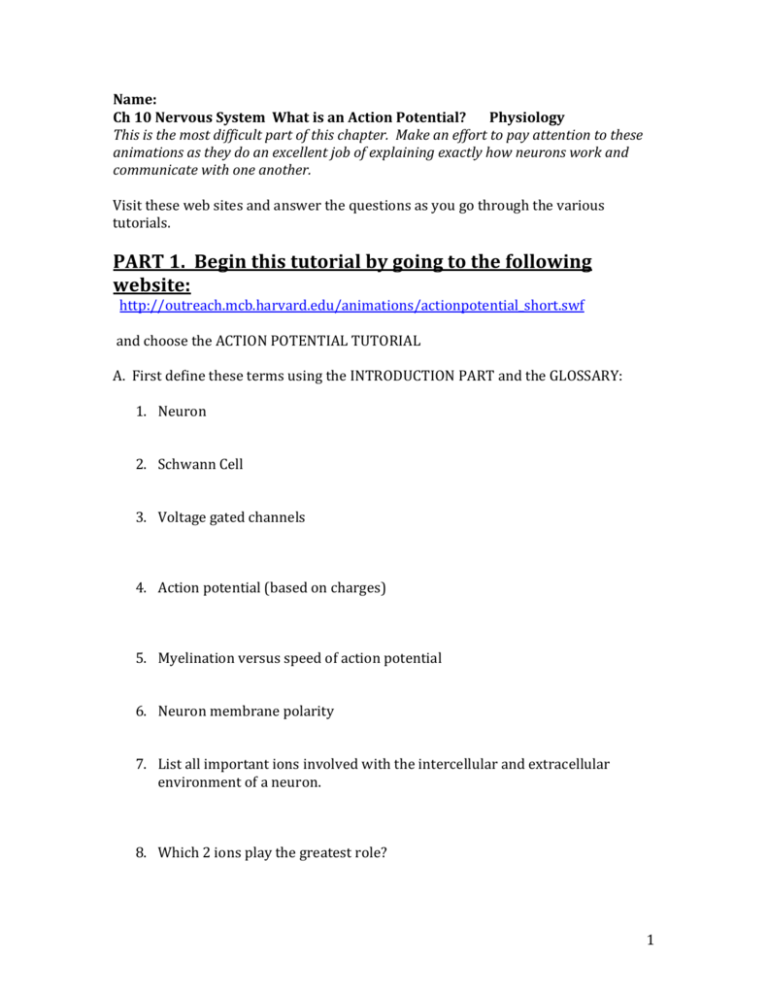
Name: Ch 10 Nervous System What is an Action Potential? Physiology This is the most difficult part of this chapter. Make an effort to pay attention to these animations as they do an excellent job of explaining exactly how neurons work and communicate with one another. Visit these web sites and answer the questions as you go through the various tutorials. PART 1. Begin this tutorial by going to the following website: http://outreach.mcb.harvard.edu/animations/actionpotential_short.swf and choose the ACTION POTENTIAL TUTORIAL A. First define these terms using the INTRODUCTION PART and the GLOSSARY: 1. Neuron 2. Schwann Cell 3. Voltage gated channels 4. Action potential (based on charges) 5. Myelination versus speed of action potential 6. Neuron membrane polarity 7. List all important ions involved with the intercellular and extracellular environment of a neuron. 8. Which 2 ions play the greatest role? 1 B. Draw a neuron membrane below showing which side is positively vs negatively charged THESE SKETCHS SHOULD BE DONE WITH COLORED PENCILS TO SHOW THE SPECIFIC PARTS. LABEL ALL IMPORTANT PARTS. C. Sketch the Sodium Potassium pump and explain how it works. D. Now go to the RESTING POTENTIAL PART. 1. Draw a cell membrane below that is in RESTING POTENTIAL.? Show the two types of gates and ions in two different colors (DO THIS FOR ALL OF THE DRAWINGS THAT FOLLOW) . * BASED ON PROTEIN STRUCTURE, WHAT IS THE MAIN DIFFERENCE BETWEEN A SODIUM VOLTAGE GATE AND A POTASSIUM SODIUM GATE? 2. Next do the exercise in this part. Which ions are on the inside vs. the outside during the resting state and what is going on with the ion gates? E. Next view the DEPOLARIZATION PART which is the first step in an action potential. 1. Explain what DEPOLARIZATION is and make a sketch showing the main events occurring. Be sure to label every part. 2 2. Next do the exercise to see how a cell membrane becomes depolarized. Draw a cell membrane below that is depolarized showing all ions along with all gates. Show which gates are closed and which are opened. What gate(s ) did you manipulate and how? F. Now view the REPOLARIZATION PART. 1. Explain what REPOLARIZATION is and make a sketch showing the main events occurring. Be sure to label every part. 2. Next do the exercise to see how a cell membrane becomes repolarized. Draw a cell membrane below that is repolarized showing all ions along with all gates. Show which gates are closed and which are opened. What gate(s ) did you manipulate and how? G. Now continue the tutorial by viewing RETURN TO RESTING POTENTIAL. 1. Which protein is responsible for restoring the original concentrations of potassium and sodium ions? 2. Now sketch a cell membrane that has returned to resting potential showing all ions and proteins involved. What has happened to the K and Na gates? 3. Fill in the blanks. An animal uses ________________ of its energy to maintain __________________. 3 H. Finish the tutorial by ZOOMING OUT. Watch the animation. What is a nerve impulse (also called an action potential)? Sketch a section of a neuron showing what happens to the + and – charges during an action potential. ****MAKE SURE YOU GO THROUGH THE SUMMARY AT THE END OF THE MODULE. YOUR OBJECTIVE IN THIS LESSON IS TO UNDERSTAND WHAT AN ACTION POTENTIAL IS ON A CHEMICAL LEVEL. COULD YOU EXPLAIN THIS BACK TO ME AS AN ESSAY QUESTION? G. Now view this cartoon about action potentials which does a great job summarizing the process. http://brainu.org/files/movies/action_potential_cartoon.swf 1. Draw and label the ACTION POTENTIAL GRAPH shown in this animation. At rest, there is a potential difference across the cell membrane of -­‐70 mV. Why? 2. Define THRESHOLD for starting an action potential. 3. Define the stage of HYERPOLARIZATION shown in this animation. What is happening exactly during this stage? 4. What happens when the neuron terminal becomes DEPOLARIZED? 4 PART 2. NOW FOR MORE PRACTICE ON THIS CONCEPT: Work through the entire tutorial on GET BODY SMART from your text book site and answer the questions that follow. http://www.getbodysmart.com/ap/nervoussystem/menu/menu.html Go to the Nervous System and CHOOSE NEUROPHYSIOLOGY, then do all TUTORIALS under the following topics to help prepare for the next quiz on this part of Ch 10. THERE ARE SOME QUESTIONS BELOW FROM THIS SITE NEUROPHYSIOLOGY DO THE ENTIRE TUTORIAL FOR EACH Tutorials: • Overview of Neuron Cell Membranes • Resting Membrane Potentials • Neuron Action Potentials 1. Label all of the ions below. Color them accordingly. 2. Define REFRACTORY PERIOD. 3. Differentiate between MYELINATED and UNMYELINATED AXONS. 5 4. Explain the difference in how an ACTION POTENTIAL travels in MYELINATED versus. UNMYELINATED AXONS. Which uses SALTATORY ACTION? Define SALTATORY ACTION. PART 3. Now go to this web site again and choose SYNAPTIC TRANSMISSION http://outreach.mcb.harvard.edu/animations/synaptic.swf A. Begin with LEARNING AND MAKING THE CONNECTIONS and THE NEURON. 1. Sketch a neuron and label the parts as shown on the animation. 2. Sketch a synapse and label all parts as shown on the animation. B. Next go to the SYNAPSTIC TRANSMISSION PART. 1. Draw 2 neurons and show how an impulse travels. 2. When an action potential reaches the end of the axon, what occurs? 3. Beginning with the inward surge of calcium, list ALL steps involved in the release and restoration of the neurotransmitters. 6 C. Now go to the last EXERCISE. 1. What happened to your neurons that enabled you to learn this game? PART 4. Now go to this web site: http://bcs.whfreeman.com/thelifewire/content/chp44/4403s.swf Watch this animation and explain how a neurotransmitter can begin the action potential that was described in the last tutorial. (This ties in the neuromuscular junction we talked about in Ch 9.) 1. TAKE THE QUIZ THAT IS AT THE END OF THE TUTORIAL AND WRITE IN THE CORRECT ANSWERS BELOW. 7 PART 5 . Next, go to this web site: http://www.blackwellpublishing.com/patestas/animations/actionp.html WATCH EACH ANIMATION. 1. Compare and contrast an action potential in a MYELINATED vs. UNMYELINATED axon. FINALLY FINISHED! Which of the below describes your understanding of ACTION POTENTIAL????? Got it!!! 8
